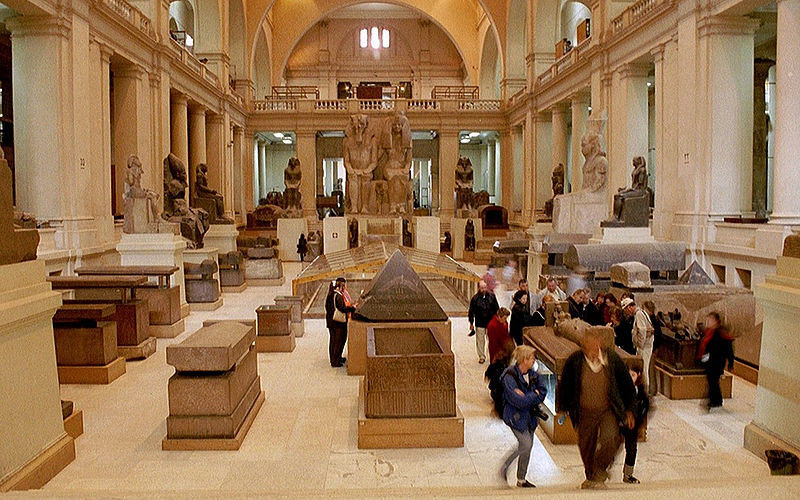
Egyptian Museum in Cairo. Contains the largest collection of ancient monuments in Egypt, and competed the British Museum and the Louvre and the Metropolitan Museum (New York). Lies and the Egyptian Museum in Tahrir Square in the heart of Cairo since 1906, contains a museum exhibit on the impact of the Pharaonic 136 thousand, in addition to hundreds of thousands of effects found in warehouses
Emergence and establishment of the museum
The story of the establishment of the museum with the world's attention after the great Herpetologist to decipher the Rosetta Stone at the hands of French scientist Champollion. The initial nucleus of the museum at the small house in a pond where the old Uzbek was Muhammad Ali Pasha, the Egyptian Antiquities registration and transfer of fixed effects the value of the Museum of Uzbek and that in 1848.
After the death of Muhammad Ali returned the theft of antiquities again and walked to his successors approach Shouts Vtdhaelt museum. In 1858 was appointed (Mariette) as the first officer (the occupancy of Antiquities) any (corresponds to what is currently head of effects). It was found that to be the presence of management and the Museum of Antiquities and therefore the selection of the Bulaq to create a museum of Egyptian antiquities and the transfer of the antiquities found during Hvaúrh
(such as the effects of Aah-hotep tomb).
* In 1863, the Khedive Ismail, the adoption of the project to establish a museum of Egyptian antiquities, but the project was not implemented, but contented himself with giving Mariette (defined digit) in front of Alontekkhana in Bulaq to expand the museum.
* In 1878 occurred in very high flood of the Nile, causing flooding and loss of Bulaq Museum of some of its contents.
* In 1881 the museum reopened in the same year he died and was succeeded by Mariette (Maspero) as Director of Antiquities and Museum.
* In 1891 AD When he increased the Museum collections were moved to Bulaq Galatasaray Giza.
* When it came to the world (de Morgan) as the interest of the museum and the re-coordination of these groups in the new museum, known as the Museum of Giza.
* In the period from 1897 - 1899 AD came to have a successor Loret Loret Morgan.
* But returned Maspero again to run the stakeholders and the Museum of the year 1899 - 1914 AD In 1902, the transfer of impacts to the current building of the museum (in the field of editing) and it was more his activity in the period of his second world, Egyptian Ahmed Pasha Kamal, who was the first to specialize in the effects Ancient Egyptian and worked for many years the museum.
* The first Egyptian director of the museum was as a (Mahmoud Hamza) was appointed in 1950.
* This was a brief guide to the museum to develop due to Maspero in 1883 but he has done a great guide for the new museum with prints and repeat from 1915 till now (but with a set of amendments).
Most of the museum
The museum consists of two floors including the ground devoted to the effects of the heavy top has been allocated for the effects of light and complete sets (such as the Tutankhamun).
* The museum houses a huge number of Egyptian antiquities from prehistoric times to the end of the Pharaonic era in addition to some of the effects of Greek and Romanian, including:
1. A group of pottery (from prehistoric times).
2. Slaah Narmer (the era of unification).
3. Statue Khasekhem (family 2).
4. Statue of Djoser (family 3).
5. Statues of Khufu / Khafre / Menkaure (family 4).
6. Kaabr statue / statues of servants (family 5).
7. Dwarf Statue SNP (family 6).
8. Statue of Mentuhotep Nebhepetre (family 11).
9. Statues of Amenemhat I / II / III (family 12).
10. Ka Statue of King Hor (family 13).
11. Statues of Hatshepsut / Tuthmosis III (family 18).
12. Tutankhamun group (family 18).
13. Treasures of Tanis group .... Etc..
14. A wide range of Almmyat Mokhtlav of the ages


Sections of the museum
Divided according to their importance or effects of the amount provided Kalksm the sixth and seventh, while the arrangements the second, third and the fourth was on the basis of chronological order and taken into account included the most important monuments in the department and other key periods in another section, and is as follows
* Section I: The king, Tutankhamun is the outcome of the discovery of one to one time period where the effects were more than 3500 pieces of antique gold in addition to the mummies.
* Section II: the old state, one of the prosperous periods in the history of ancient Egypt, a period and the period of building the pyramids of King Khufu, a period in which the rule of four families governor "of the third-sixth."
* Section III: Central State.
* Section IV: the modern state the period of the Empire, the great Ramses II and Tutankhamun and Akhenaten and Merneptah and Tuthmosis
* Section V of the family "21 to 30" meaning the way for the entry of Alexander the Great to Egypt.
* Section VI: Department of papyrus and the currency, which were collected in each papyrus.
* Section VII: Section "scarabs"




No comments:
Post a Comment